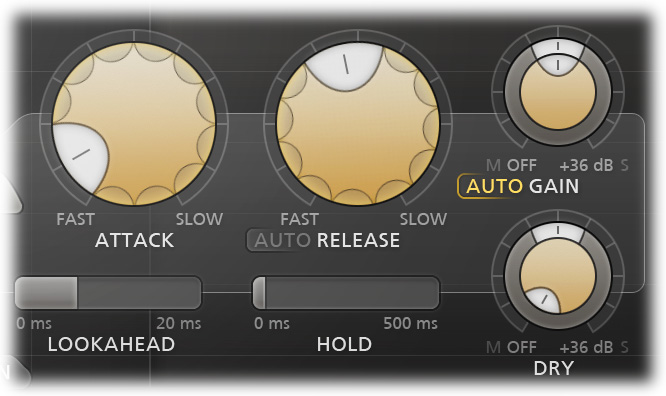FabFilter Pro-C 2 online help
Table of contents
FabFilter Pro-C 2 Help
Introduction
Using FabFilter Pro-C 2
Full screen mode, resizing and scaling
Presets
Purchasing FabFilter Pro-C 2
Support
Time controls
The right part of the main compressor settings panel contains the controls that affect the smoothing and curve shape of the gain change signal, and the wet/dry mixing controls.

- The Attack knob determines how fast compression will kick in, ranging from 0.005 ms
(very fast) to 250 ms (very slow). For transient-rich program material like drums, fast attack
times are needed to minimize overshoot. For other program material, too short attack times may
dull the sound or introduce audible distortion. FabFilter Pro-C 2 is capable of very fast
attack times and they are program dependent.
- The Release knob sets the time that the compressor takes to recover from gain reduction. The various compression characteristics of Pro-C 2 use different release models, and in most cases, the release time is very program dependent. This means that Pro-C 2 recovers very quickly from compression after a transient, and quite slowly after longer periods of gain reduction. Note: When Auto Release is used, the Release knob will adjust the overall effect of the auto release feature on the release time.
- The Auto Release button (the AUTO label next to RELEASE) enables a smart auto release feature. When enabled, the compressor adjusts the release time depending on the current amount of gain reduction, so this actually introduces an additional form of program dependency. When Auto Release is used, the Release knob will adjust the overall effect of the auto release feature on the release time.
- The Lookahead slider sets how much advance time Pro-C 2 will use to anticipate peaks in the audio signal. Using a bit of lookahead can help to preserve transients and results in much more transparent gain reduction. Because lookahead causes additional latency, it can be globally enabled or disabled in the bottom bar.
- The Hold slider sets the time with which peaks in gain reduction will be prolonged. Applying a bit of hold time can help increase the transparency of gain reduction. With longer hold times, you can achieve nice pumping effects.
- The Wet Gain knob adjusts the gain of the signal after it has been compressed. This is also known as make-up gain because it compensates for the gain reduction introduced by the compressor. The pan ring around the Wet Gain knob controls the balance between mid and side. This can be especially useful when applying make-up gain after mid-only or side-only compression.
- When Auto Gain is enabled (using the AUTO button next to GAIN), automatic make-up
gain is applied to the processed signal, depending on current settings for Threshold, Ratio,
Knee and Attack. Auto Gain helps you to keep the audible audio level the same while adjusting
the controls. The Auto Gain algorithm is aware of mid-only or side-only processing. So for
example, if you're compressing 100% mid-only, Auto Gain will only apply make-up gain to the mid
signal and leave the side-signal untouched.
Note that the auto-gain algorithm doesn't actually measure loudness to determine which gain to apply. It just makes an educated guess, so you might want still to tweak the output gain in some situations. - The Dry Gain knob controls the amount of dry (uncompressed) input signal that is added to the output. This is called parallel compression: the dynamics in the dry signal are preserved while the compressed signal adds body and character to the overall sound. The advantage of this is that the sound is reinforced where it needs it, but without the risk of crushing any peak transients.
Program dependency
The different compressor styles in FabFilter Pro-C 2 all have their own kind of program dependency. This means that the compressor reacts differently to different kinds of input (program material). For example, Pro-C 2 will recover very fast from transients (fast changes/peaks), but will react quite a bit slower after longer periods of gain reduction. Both the attack and release times are less or more program dependent, depending on the chosen compression style.
Next: Side chain section
See Also
Dynamics controls
Using FabFilter Pro-C 2
